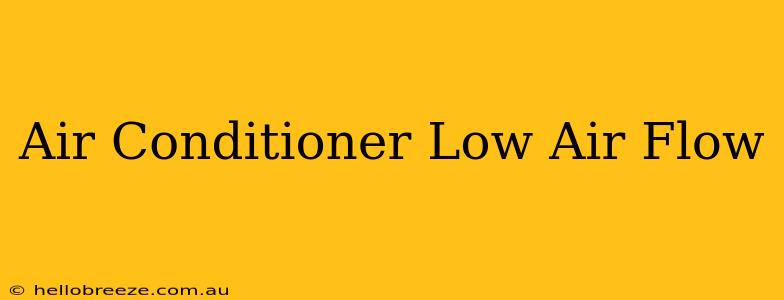Is your air conditioner struggling to keep up, leaving you sweltering in the heat? Low airflow is a common problem with AC units, but thankfully, often one that can be resolved with some simple troubleshooting. This guide will walk you through the most common causes of low airflow in your air conditioner, and provide practical solutions to get your cool air flowing again.
Diagnosing the Problem: Why is My AC Blowing Weak Air?
Before you call a technician, let's try to identify the source of your low airflow. Several factors can contribute to this issue:
1. Dirty Air Filter: The Most Common Culprit
A clogged air filter is the number one reason for reduced airflow in an air conditioner. A dirty filter restricts air intake, forcing your AC unit to work harder and ultimately, blow less air.
- Solution: Check your air filter. If it's dirty or dusty, replace it with a new one. This is often a quick and inexpensive fix that can dramatically improve airflow. Remember to check your filter regularly, ideally once a month, especially during peak usage seasons.
2. Frozen Evaporator Coil: A Serious Issue
A frozen evaporator coil is a more serious problem. Ice buildup restricts airflow and can severely damage your AC unit if left unaddressed. This is often caused by:
-
Dirty air filter: As mentioned above, a dirty filter restricts airflow, leading to freezing.
-
Low refrigerant: Insufficient refrigerant can cause the evaporator coil to freeze.
-
Restricted airflow: Blocked vents or other obstructions can also contribute to freezing.
-
Solution: Do not attempt to defrost the coil yourself by using a hairdryer or other heating methods. This can damage your unit. Contact a qualified HVAC technician to diagnose and repair the problem. They'll identify the root cause – whether it's a refrigerant leak, a dirty filter, or another issue – and fix it safely.
3. Blocked Vents and Registers: Obstructions to Airflow
Check all your air vents and registers. Anything blocking the vents, such as furniture, curtains, or rugs, will restrict airflow.
- Solution: Ensure all vents are open and unobstructed. Move furniture and other items away from vents to allow for optimal airflow.
4. Faulty Blower Motor: A Mechanical Problem
The blower motor is responsible for pushing air through the system. If it's malfunctioning, it won't be able to circulate air effectively. Symptoms include weak airflow, unusual noises, or the blower motor failing to start completely.
- Solution: A faulty blower motor requires professional repair. Contact an HVAC technician for diagnosis and replacement if necessary.
5. Refrigerant Leaks: The Silent Culprit
Low refrigerant levels can drastically reduce cooling capacity and airflow. Refrigerant leaks are often difficult to detect without specialized equipment.
- Solution: Contact an HVAC technician to diagnose and repair any refrigerant leaks. Refrigerant is a specialized substance and should only be handled by trained professionals.
Maintaining Your AC for Optimal Airflow
Preventative maintenance is key to avoiding low airflow issues. Regularly performing these tasks will keep your AC running smoothly:
- Regular filter changes: This is the single most important maintenance task.
- Clean coils: Cleaning the evaporator and condenser coils improves efficiency and airflow.
- Annual professional inspection: An annual checkup by an HVAC technician can prevent larger, more costly issues down the line.
By addressing these potential problems, you can significantly improve the airflow from your air conditioner and enjoy a cool, comfortable home. Remember, for more serious problems like frozen coils or suspected refrigerant leaks, contacting a qualified HVAC technician is crucial. Don't hesitate to seek professional help when needed – it can save you time, money, and frustration in the long run.

